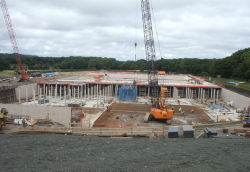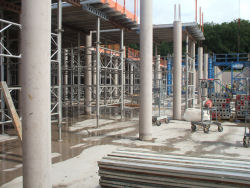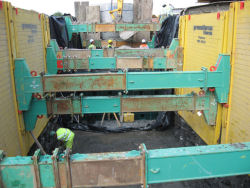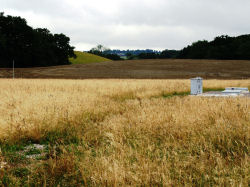Barrow Gurney Reservoir |
|
Whole Project Award
Project Team:
Client:
Bristol
Water
Design: Black
and Veatch
Construction: Costain
 |
|
The project
The objective of the project was to construct a 40mgl four-chamber partially buried and covered concrete reservoir with ancillary emergency pumping equipment. In addition, a controlling flow-brake unit for emergency or maintenance emptying was to be constructed, which would also serve as stormwater retention to prevent flooding of an adjacent stream, used to carry discharges.
The six-acre site was contained within the Barrow Gurney treatment complex, just to the south of Bristol, on a part-brownfield site that had been used for storage. To maintain the integrity of supplies to around 250,000 properties to the north, south and east of Bristol, connections were to be made to several existing and one new 13-km pipeline (the Northern Relief Main, which was assessed separately under CEEQUAL and received a ‘Good’ Award).
 |
|
Environmental considerations
A mature hedgerow traversed the footprint of the reservoir site, and environmental reports had indicated that this was used as a bat corridor linking two woodland areas on either side of the site. An innovative approach was taken to relocate the hedgerow as it stood, rather than replace it with a newly planted hedge that would require several years to mature.
During the dormant winter period, the entire hedgerow was relocated to a prepared trench at the edge of the site. Spring was awaited eagerly to see if the hedge would take. To the project team’s surprise and delight, the whole hedge blossomed and put on vigorous amounts of fresh growth. In fact, by late April three bird’s nests were recorded within the hedgerow with pairs of blackbirds, hedge sparrows and chaffinches all raising young.
Three semi-mature oak trees that were in the footprint area of the reservoir had to be felled. The timber was then used to provide additional bat roosts and invertebrate habitats along the edges of adjacent woodlands.
 |
 |
 |
|
Protecting the environment
The site is bordered by a small stream that was to be used to disperse discharge from rainwater displacement from the reservoir and, in an emergency or for maintenance, for dewatering of one or more of the reservoir chambers. In order to protect downstream properties, a valve-controlled flowbrake chamber that can retard the rate of discharge and provide dechlorination of potable water was built adjacent to the main structure. This ensures that no damage can result to the environment or to third parties below the structure.
 |
|
Waste minimisation and biodiversity
All excavated material was retained on site and reused for green roofing and landscape bunding that was planted with trees, grasses and wildflowers to provide a haven for insects and foraging areas for bats, birds and small mammals. This gave huge savings on transport and disposal costs and substantially reduced the carbon footprint of the project.
Use of materials
During construction of the reservoir, reusable aluminium and steel formwork was used in preference to wood. In fact, the use of wood in the whole construction process was minimal (mainly for fencing) and all timber products used were from FSC-certified sources, a condition built into contracts issued to sub-contractors.
 |
|

